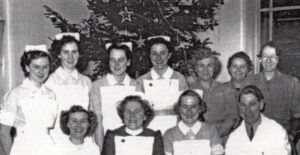
I CHOSE a midwifery school with a pin and applied to Leicester. Matron was suspicious of London-trained nurses: she didn’t know that my general nursing hospital was also small and parachial, so I wasn’t dismayed by the minute rooms and oddly-adapted premises at Bond Street. She felt, however, that pupils used to extensive facilities might be unhappy, which couldn’t help the mothers. I found that the excellent training negated any drawbacks.
The hospital, which started in six terraced houses, had served factory workers. Living rooms became tiny two-bedded wards where the babies also stayed. That made it wonderfully homely, though had we wished to, we had nowhere else to put the cots. These wards opened off a corridor cut through the terrace, their pastel-coloured decoration reflecting into the passageway. It looked quite unlike a hospital — advanced thinking for 1951.
Cramped for space, we moved much furniture about — and not just furniture either. ‘Jordan’ was a small landing down three stairs and up again to reach the far rooms. We always tried to put lightweights ‘over Jordan’, but sometimes delivered a very large lady, when all closer beds were full. Then we used stretchers and woman-power. Mothers stayed for ten to 14 days, five of these in bed.
The delivery suite was first-class – large, well quipped, built with no expenses spared in the 1930s, aseptic and cold. We were often so busy that babies arrived on trolleys or in waiting rooms. Women fought to book in where they themselves had been born, where comforting and help came together. Crowded ante-natal clinics in an old factory gave special appointments to country women catching once-a-week buses back into the country. Unusually we had a milk bank, with milk donated by local mothers, so our ‘prems’ flourished (50 years later we again think this idea is good).
Housekeeper Florence thoroughly spoiled the night-duty pupils. We slept in a sort of garden pavilion. Quiet all day, we were awakened each afternoon to the cheerful banter of dustmen returning to the neighbouring depot. On Sundays we slept late, until 5.30 when church bells began. Most of the old churches had melodious full peals then. During the night we drank tea in the operating theatre which was kept clear for emergencies. Its huge window overlooked the railway.
We waved to the sorters on the mail train as it left the Great Central Station. They could just see us out of their narrow high windows.
I spent my days off cycling into the countryside, which was only about 20 minutes away and gloriously rural.
Leicester was interesting with its fine market, and such activity when the factories in town had lunch break. One, Fox’s, made hard-boiled sweets and everyone downwind knew the flavour of the week.
We planned to go swimming, so one evening, in clinic, I found a map and confidently led off to Bath Street — but when we arrived there were no baths! Years later I learned that there had once been baths there — banana-shaped no less.
I once went to see the ‘Peacock Pavement’ which was then in the cellar of a corsetry shop which embarrassed elderly men had to go through. It was incredibly dark! The Roman mosaic is much better seen now, In Jewry Wall Museum, even if it isn’t in its original site.
Nor is Leicester Royal Infirmary Maternity Unit still in its original site. A purpose-built unit has replaced all our homely makeshifts and the area has been completely redeveloped — but that old hospital had an excellent record. To anyone in the profession at that time, ‘Bond Street’ didn’t first mean fashion.
Rose Bakker.








